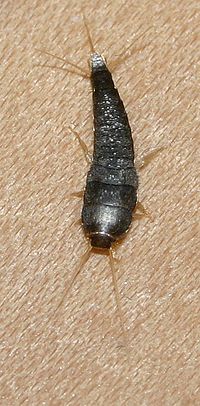Thysanura
| Thysanura Temporal range: [1]
| |
|---|---|

| |
| A silverfish, Lepisma saccharina | |
| Scientific classification | |
| Kingdom: | |
| Phylum: | |
| Class: | |
| Subclass: | |
| Order: | Thysanura
|
| Families | |
Thysanura is an order of insects, encompassing silverfish and firebrats, known for their three long caudal filaments.
The families Machilidae and Meinertellidae of the jumping bristletails were once included with Thysanura. Occasionally, the correspondingly restricted order Thysanura is referred to as Zygentoma.
Etymology
The name Thysanura is derived from the Greek thysanos for fringe, tassel, tag and oura for tail, a reference to the three fanned out caudal filaments.
Description and ecology
Silverfish are so called due to the silvery glitter of the scales covering their bodies. Their movement is "fish-like" and makes it look as if they are swimming. They are less than 1 centimetre (0.39 in) long, and found in damp corners or amongst books and paper in houses.
Silverfish have flattened bodies and may be elongated or oval in shape. They have flexible antennae and small or absent compound eyes. They have short mandibles and relatively unspecialised mouthparts. Many species also have a number of short appendages on their abdominal segments, but the most distinctive feature of the group is the presence of three long, tail-like filaments extending from their last segment. The two lateral filaments are formed from the abdominal cerci.[2]
They may be found in moist, humid environments or dry conditions, both as free-living organisms or nest-associates.
Silverfish feed on cereals, paste, paper, starch in clothes, rayon fabrics and dried meats.[3] Silverfish can sometimes be found in bathtubs or sinks at night, as they have difficulty moving on smooth surfaces and so become trapped. Wild species often are found in habitats such as caves, and some are commensals living in association with ant colonies, e.g., Trichatelura manni [4] .
There are no current species formally considered to be at conservation risk, though several are troglobites limited to one or a few caves or cave systems, and these species run an exceptionally high risk of extinction.
Families
Lepismatidae is the largest family, widespread with more than 200 species, many living in human habitations. The Nicoletiidae are small and live in soil litter, humus and under stones. The Lepidothrichidae are represented by two species Lepidothrix pilifera from Baltic Amber and Tricholepidion gertschi from forests of northern California. Three species of Maindroniidae are found in the Middle East and in Chile. The Ateluridae live in nests of ants and termites and are small and blind.[5]
Reproduction
Silverfish have an elaborate courtship ritual to ensure exchange of sperm. The male spins a silken thread between the substrate and a vertical object. He deposits a sperm packet (spermatophore) beneath this thread and then coaxes a female to walk under the thread. When her cerci contact the silk thread, she picks up the spermatophore with her genital opening. Sperm are released into her reproductive system, and then she ejects the empty spermatophore and eats it.
Silverfish continue to moult throughout their life, with several sexually mature instars, unlike more advanced insects. They are relatively slow growing, and lifespans of up to four years have been recorded.[2]
References
- ^ Hoell, H.V., Doyen, J.T. & Purcell, A.H. (1998). Introduction to Insect Biology and Diversity, 2nd ed. Oxford University Press. p. 320. ISBN 0-19-510033-6.
{{cite book}}: CS1 maint: multiple names: authors list (link) - ^ a b Hoell, H.V., Doyen, J.T. & Purcell, A.H. (1998). Introduction to Insect Biology and Diversity, 2nd ed. Oxford University Press. p. 343. ISBN 0-19-510033-6.
{{cite book}}: CS1 maint: multiple names: authors list (link) - ^ Silverfish
- ^ Reproductive Morphology and Behavior of a Thysanuran, Trichatelura manni, Associated with Army Ants, R. Torgerson, R. D. Akre 1969. Annals of the Entomological Society of America, 62, pp. 1367-1374
- ^ Helmut Sturm Zygentoma in Resh VH, Cardé RT. (eds.) (2003) Encyclopaedia of Insects. Academic Press. pp. 1203–1205
- Grimaldi, D. and Engel, M.S. (2005). Evolution of the Insects. Cambridge University Press. ISBN 0-521-82149-5.
{{cite book}}: CS1 maint: multiple names: authors list (link) - Charles A. Triplehorn and Norman F. Johnson, Borror and DeLong's Introduction to the Study of Insects, 7th edition (Thomas Brooks/Cole, 2005), pp. 177–180
- Firefly Encyclopedia of Insects and Spiders, edited by Christopher O'Toole, ISBN 1-55297-612-2, 2002
External links
- Thysanura – Tree of Life Web Project
- Virginia Extension Service Article
- Harvard University Fact Sheet on silverfish and firebrats
This article incorporates text from a publication now in the public domain: Chisholm, Hugh, ed. (1911). Encyclopædia Britannica (11th ed.). Cambridge University Press. {{cite encyclopedia}}: Missing or empty |title= (help)
